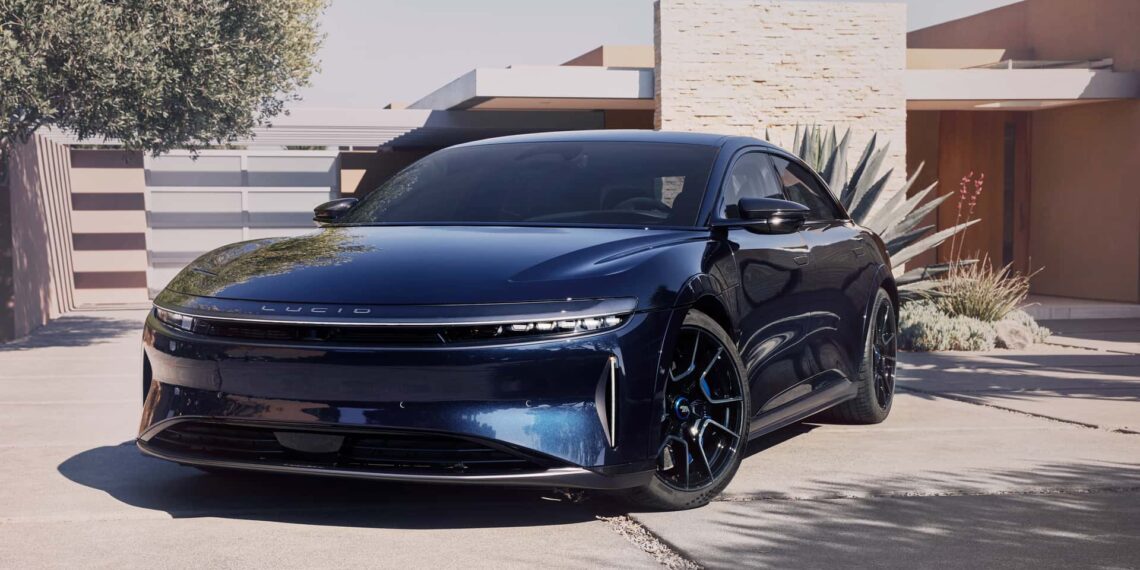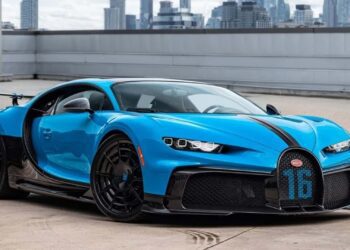I straighten the wheel as we join the highway on-ramp, with Los Angeles’ morning rush hour subsiding. We’re in full power mode, 1,234 horsepower to be exact, and I’ve got about a half-mile gap to the car in front. Lucid engineer David Lickfold is riding passenger, and as he sees the open road ahead, he says, “Floor it.” In an instant, the gap had vanished, with us barreling towards the poor crossover ahead. This 5,336-pound electric sedan hadn’t just sprinted. It rocketed from a crawl in a way I’ve only felt once before.
Almost exactly a year ago, I was in the Malibu canyons with the 1,877-hp Pininfarina Battista, a $2.2 million hypercar, of which just a few will ever exist. A hypercar that, shortly after my drive, went on to set a record as the quickest production vehicle ever, reaching 60 mph in 1.79 seconds. Its record stood mere months until its mechanical sibling, the Rimac Nevera, shaved 0.05 seconds off its time, with the record now standing at 1.74 seconds.
Since that day in the Battista, I’ve never felt another vehicle that accelerated as ferociously, and mind you, I drove a Bugatti Chiron Super Sport days after. That is until I drove the 2024 Lucid Air Sapphire. If the only thing that comes to mind after a drive in a luxurious sports sedan is a $2.2 million hypercar, it’s bound to be extraordinary.

Quick Stats
| Motor | Three Permanent Magnet Motors |
| Output | 1,234 Horsepower / 1,430 Pound-Feet |
| 0-60 MPH | 1.89 Seconds |
| Range | 427 Miles EPA |
| Base Price | $249,000 |
The secret to the Sapphire’s hypercar performance levels is, of course, its powertrain. By combining three electric motors, one up front and two out back, the range-topping Air produces 1,234 hp and 1,430 pound-feet, more than any other production sedan. To put all that power down, the Sapphire channels it to all four wheels, allowing it to dash to 60 mph in 1.89 seconds, complete the quarter mile in 8.95 seconds and top out at 205 mph.
On paper, it’s easy to assume the Sapphire is just a quicker Air, but it’s far more than that. To handle its tremendous output, the range-topping Air gets wider wheels and tires, requiring fender extenders to accommodate them. Its tires are bespoke, too, with Michelin developing a unique compound that combines its Pilot Sport 4S and Pilot Sport Cup 2 tires to deliver maximum grip while retaining relatively low rolling resistance to maximize range.
It draws power from a 118-kilowatt-hour battery, the same as the Air Grand Touring, but thanks to the addition of sticker rubber and updated aero, its range is slightly reduced to an EPA-estimated 427 miles, still beating the Tesla Model S Plaid’s 396-mile range.

David Lickfold, as mentioned earlier, is not just a Lucid engineer. He’s the brand’s Senior Director of Chassis and Vehicle Dynamic Engineering. During our drive, he explained that for the Sapphire to meet its performance targets, Lucid had to develop its torque-vectoring control algorithms and traction control system in-house. Previously, the carmaker sourced its traction system from a supplier as it was quick enough to keep up with less powerful lower-trimmed models.
Working with 1,234-hp, however, is a whole other story. It required engineers to complete thousands of launches to fine-tune the Sapphire, which also pays dividends in the bends. Although my time in the top-tier Air was brief, Lickfold was eager to show me the limits of this new in-house tech. So midway through a sharp corner, he asked that I again floor it.

I hesitated. We’re talking about one of the most powerful production cars ever. Noticing my stutter, Lickfold simply said, “Go, go, go.” And so I did. With my foot pinned to the floor mid-corner, I expected the back to step out and prepped myself to countersteer. But nothing happened. The Sapphire put as much power as it could down without a chirp from its Michelin rubber.
I was hooked. I tried it again and again. Even on cratered road surfaces, the Sapphire never broke a sweat. Although these systems make you feel the car is doing much of the work to keep you pointed in the right direction, I’m happy to have them in a car with this much power. Don’t worry. Lickfold assured me the Sapphire would still rip a proper drift with traction control disabled.

Diggin into the details, the Sapphire rides on steel springs and adaptive dampers like the standard Air models, but they’ve been returned, as have its bushings, anti-roll bars, and, crucially, its steering software. It lets you pick between four drive modes: Smooth, Swift, Sapphire, and Track. Its behavior changes drastically between them, retaining a cushy daily-driver-friendly ride in Smooth while firming up considerably in Sapphire.
There is little body roll in the bends, and its body motions are excellently controlled. It’s understandably more raw than other Airs, but never overly so. After all, this is still a luxury-oriented sedan. Still, it hustled up a twisty road effortlessly. Couple its revised chassis with its traction wizardry, four-wheel steering, and true torque vectoring system, and you have a car you’ll never be able to push to its limits on public roads.
Like all Lucids, the Sapphire always has some form of regenerative braking engaged. Thus I never got a chance to truly exercise its massive carbon-ceramic brakes as the single pedal mode is aggressive enough to slow you nicely even from a full-on sprint. Its stoppers measure 16.54 inches up front with 10-piston calipers and 15.35-in out back with four-piston calipers, so I’m sure they’re up to the task of keeping this 5,336-lb sedan in check.

Seeing how well the Sapphire behaved, I asked Lickfold what his team benchmarked it against. I instinctively thought Tesla Model S Plaid, but he quickly corrected me. The team only sought to beat the Tesla’s 0-60 time, nothing else. Regarding driving dynamics, the carmaker extensively tested its flagship against the BMW M5 CS and Cadillac CT5-V Blackwing, two of the best-driving sedans ever made. In fact, Lickfold explained that his team loved the CS so much that they opted to keep it in their long-term test fleet.
At this point, it’s worth pointing out that my time in the Sapphire was brief, following a pre-planned route in an almost-production-ready prototype. As good of a car, as I think the Saphire is, it’s easy to shine on roads selected to highlight its best features. I’ll have to follow up with a full review later to see how these early thoughts mature with more seat time.

The 2024 Lucid Air Sapphire costs $249,000, and every option is pre-selected. It comes only finished in Sapphire Blue Metallic, although the carmaker is looking to add other options. Its roof is made of metal with no glass option available, and its exterior trim comes standard with the stealth package, darkening elements that would otherwise be light silver on other models. The only wheel option is a staggered set with 20s up front and 21s out back. These include an aero cover to help the Sapphire reach its maximum range.
Inside is a similar story. The only interior color option is Sapphire Mojave, blending Nappa Leather and Alcantara surfaces. The cabin has an almost charcoal grey finish which plays nicely with the dark exterior. Materials aside, the Sapphire’s interior and onboard tech are virtually unchanged. Its menu theme has a trim-specific Sapphire blue scheme, bringing in some of the exterior finish.

The Sapphire is Lucid’s halo car, and the carmaker knows that a quarter-million-dollar sedan likely won’t sell in massive numbers. But it’s not supposed to. Like all halo products, its goal is to draw attention to the brand while showcasing what it can truly do. Thus the idea of having all Sapphires look alike starts to make sense. Aside from a few aero bits like its rear trunk-lid spoiler and wheel arch extenders, it looks much like any other Air at first glance.
Only when you get closer, do its stylistic changes become apparent, like its widened and lowered stance. It’s sort of an “if you know, you know” type of car. It may still look like an elegant four-door, but as soon as you see its dark blue paint, you instantly know it’s more than that.
The Lucid Air Sapphire is a truly impressive machine. At $249,000, it costs exactly twice what a Grand Touring does, but it’s a vastly improved product on first impressions. It’s not just a straight-line monster. So much time and consideration has gone into ensuring it handles all that power well. Whether it be its bespoke rubber, in-house traction control system, or unique drive modes, the Sapphire takes the idea of a luxury sports sedan to extremes.
With 1,234 hp on tap, it stands in its own category, reminding me only of the seven-figure Battista. I’ll leave you with the last nugget of info Lickfold gave me. Although its 0-60 time is a claimed 1.89 seconds, the Sapphire clocked much quicker during testing, entering the 1.7-range. The world’s quickest sedan is only just getting started.































